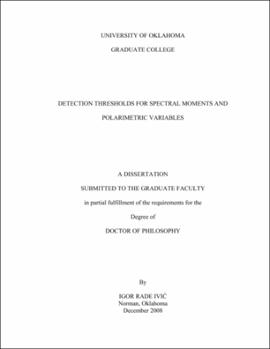| dc.description.abstract | Presently, the Signal-to-Noise-Ratio (SNR) measurement is used to determine the presence of a weather signal for Weather Surveillance Radar - 1988 Doppler (WSR-88D). Growing popularity of polarimetric radars prompts the need for improved signal detection scheme. Namely, the ongoing upgrade of the WSR-88D network to dual polarization results in a 3 dB reduction of the SNR per channel because the existing transmitter power is split between horizontal (H) and vertical (V) channels. Therefore, the radar sensitivity is degraded and many valid weather signals may be discarded if the current censoring scheme is retained. In this work, statistical techniques of mitigating the impact of the 3 dB SNR loss with the goal of improving data censoring for the dual-polarization system are examined. First, the performance and implementation of a classical likelihood-ratio method is investigated. It is concluded that such a method is not practical for operational systems due to insufficient processing capability of the signal processor. With the system constraint in mind, several efficient methods based on the signal coherency in sample-time and across channels, such as power and autocorrelation measurements in H and V channels, as well as the cross-correlation of signals from the H and V channels, are proposed. Statistical analyses of various combinations of these variables are performed using Monte Carlo simulations. The performance is further demonstrated and verified using time series data collected by the research polarimetric radar (KOUN), operated by the National Severe Storms Laboratory. Both the statistical analysis and the performance comparisons on time series imply that the novel approach has the potential to significantly improve the signal detection on dual-polarization weather radars; thus mitigating the impact of the 3 dB SNR loss in the WSR-88D radars. | |
